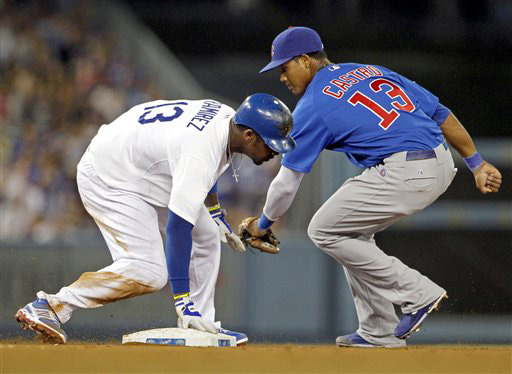There is an old saying in baseball, one that we’ve all heard a hundred times – perhaps even a thousand: “It will look like a line drive in the box score.” And while this saying generally applies to a lucky bloop or squib single, the gist of the saying is that something seemingly insignificant happened that was actually kind of big or important.
One such moment occurred in Tuesday night’s disappointing 3-2 loss by the Dodgers to the lowly Chicago Cubs, a team which, quite frankly, the Dodgers were expected to and should have swept – especially with their ace and arguably the best pitcher in all of baseball on the mound.
It wasn’t a bloop or squib single; in fact, it didn’t involve a hit at all – well, not directly. It involved a fly ball to the right field gap in the bottom of the 4th inning by Dodger second baseman Mark Ellis with Hanley Ramirez on first base, who had led off the inning with a single to left (hence that not directly thing). Ellis’s opposite field fly ball was caught by Cubs center fielder Junior Lake near the warning track and much to the surprise of Lake (and perhaps the 52,326 in attendance at Dodger Stadium), Hanley tagged up from first and slide safely into second base and into scoring position.

Ramirez caught everyone by surprise when he tagged up from first base on a fly ball to the right field gap.
(Photo credit – Reed Saxon)
As Little Leaguers, we were taught that when you are on first base with less than two outs you always go half way to second base on fly balls so that you can advance to third (or perhaps even score) if the ball is dropped, but if (and usually when) the ball is caught you can safely return to first base without being doubled-up. This is so entrenched in our minds that most people (players and fans) do not expect a runner on first to tag up and advance to second, and for the life of me I could never understand why.
When you think about it, the distance from right field to second base (especially the gap) is basically the same distance as left field is to third base, yet you frequently see guys tagging up from second and advancing to third on fly balls to left, but you rarely see guys tag up from first base and advancing to second. Now I certainly understand that possible dropped ball thing, but how often does this actually happen in the major leagues? My guess is probably less than one percent of the time.
I also understand that such a move has its risks and should only be attempted by faster runners (as is Hanley Ramirez) but I cannot understand why it isn’t employed more often – especially in close games, as was the one on Tuesday night.
But alas, following a walk to Andre Ethier, a strikeout by Juan Uribe that included a wild pitch to advance Ramirez to third and Ethier to second, followed by a wise intentional walk to A.J. Ellis to load the bases, pitcher Clayton Kershaw struck out, thus making all of this a moot point and a game-changing moment that wasn’t.




 August 28th, 2013 at 8:18 am
August 28th, 2013 at 8:18 am  by Ron Cervenka
by Ron Cervenka  Posted in
Posted in 
